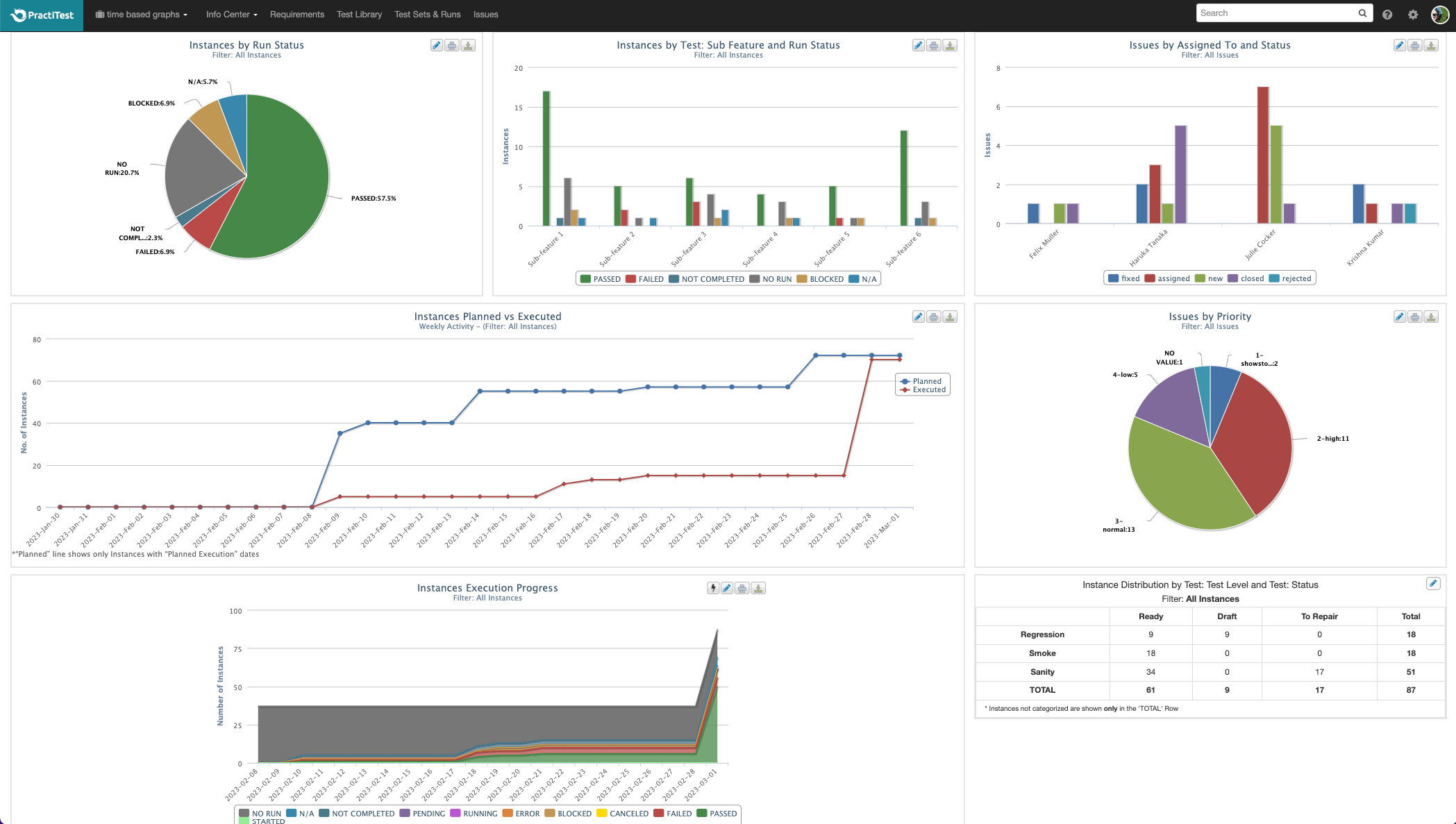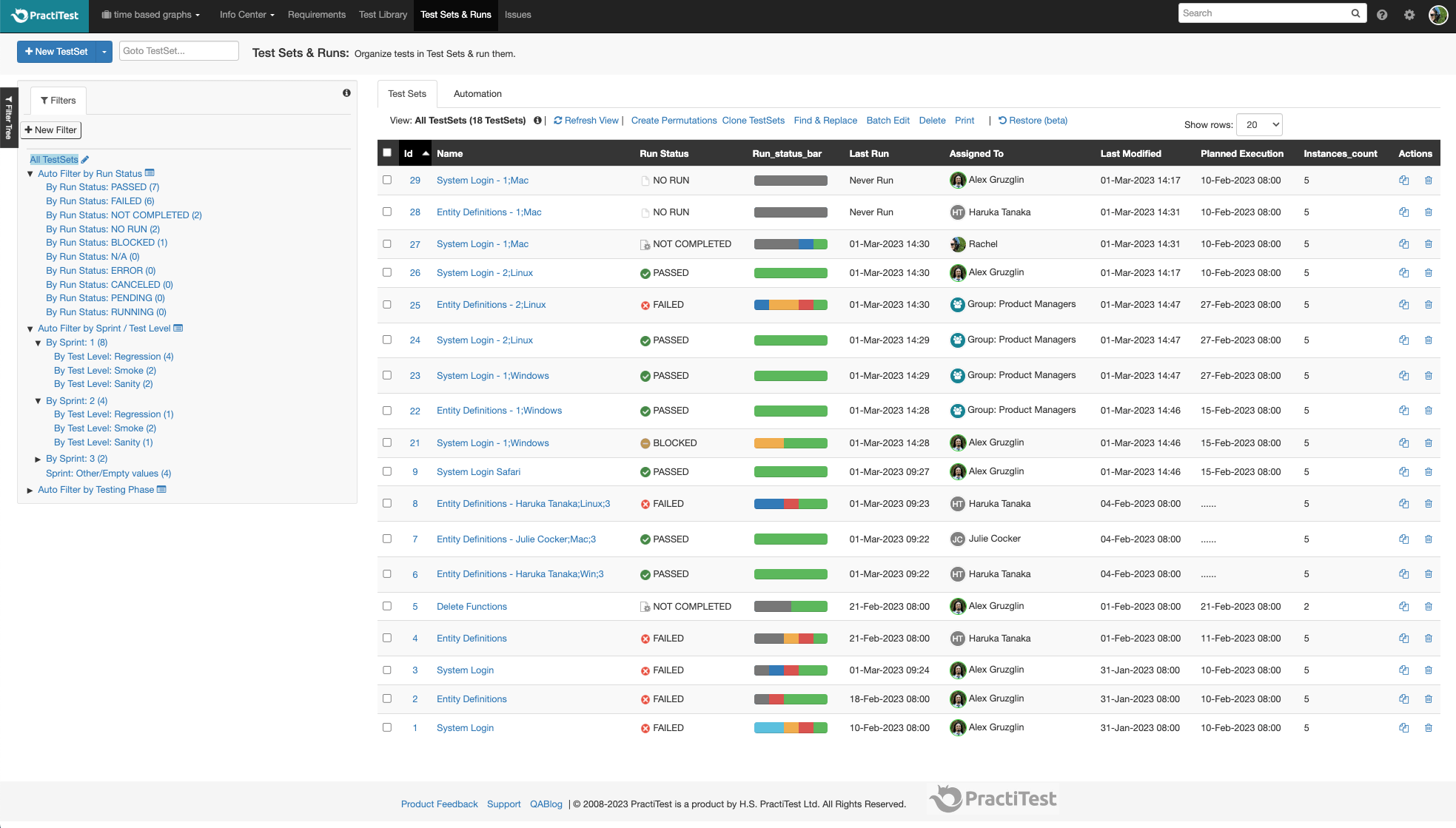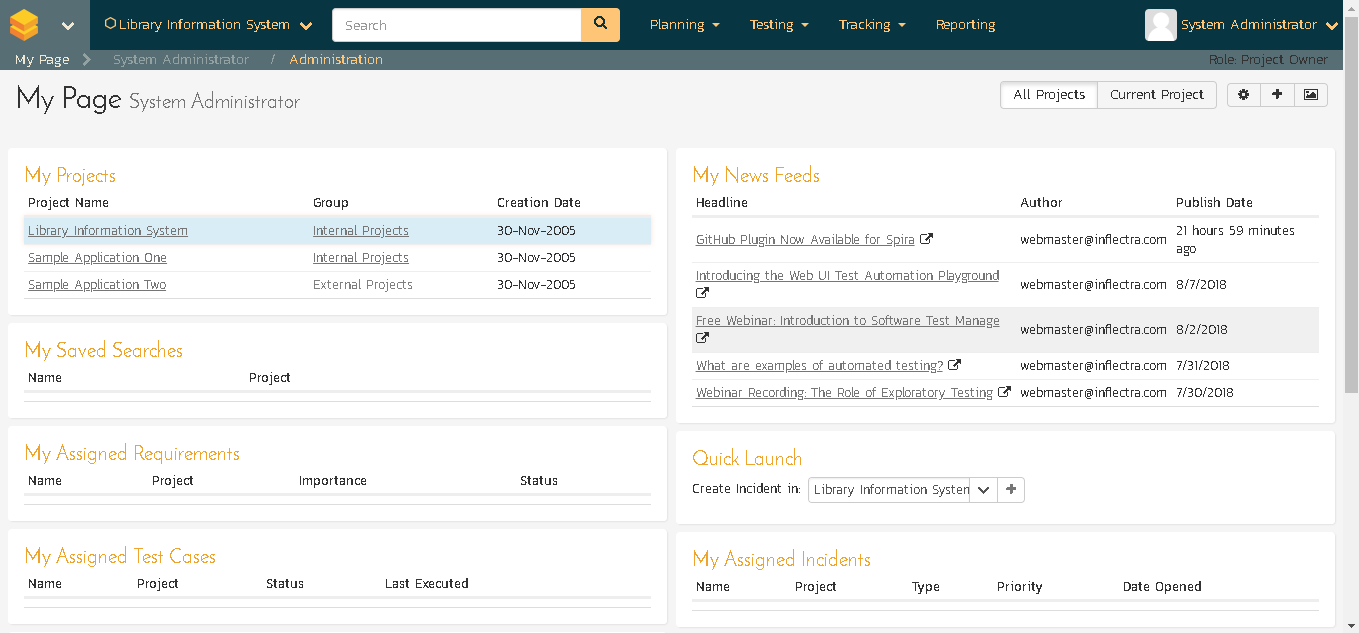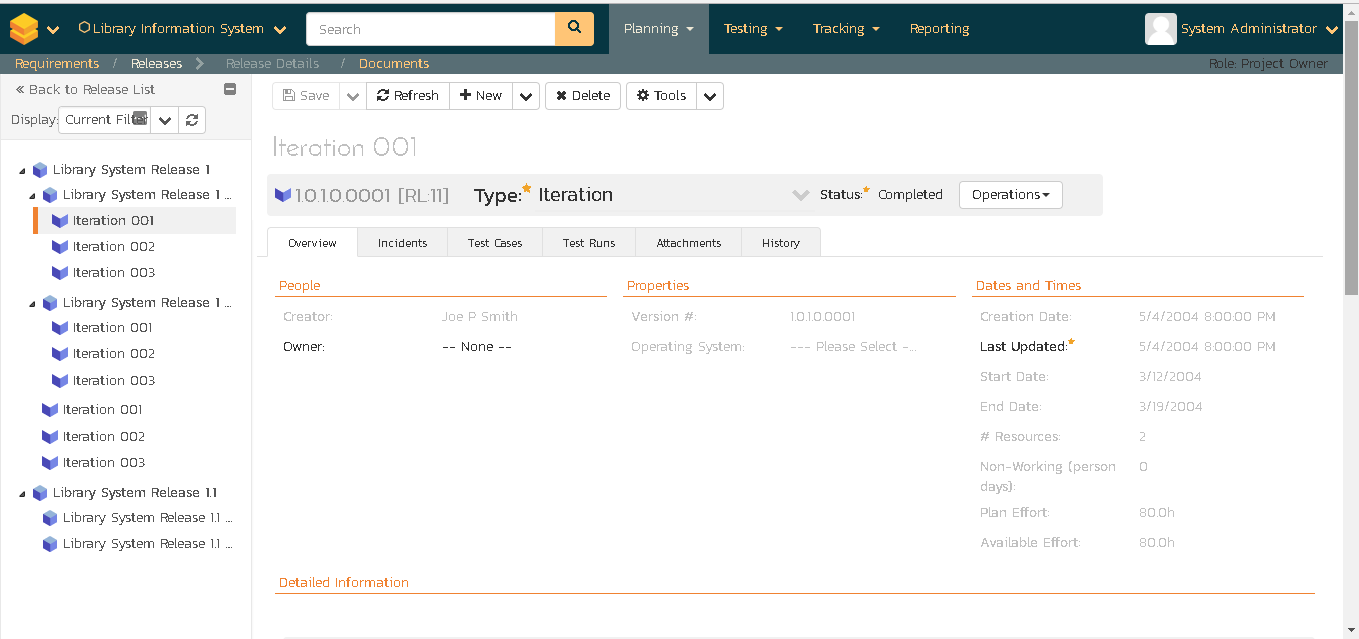PractiTest vs. SpiraTest
Searching for a test management solution is not an easy task. There are many possible options to choose from and each of those promises to be the best tool for your QA management needs. Even though the selection is vast, it is best to focus on a small amount of test management tools (2-3) and compare their main features before you proceed and sign up for a free trial with real testing data.
PractiTest vs. SpiraTest At a Glance
Both of these tools are End-to-end test management solutions that cover the entire QA process from Requirement, Test Sets & Runs, Issues, and reporting, while having a large variety of 3rd party integrations.
PractiTest is a QA management platform suitable for medium-large organizations. It has a unique data organization and visualization approach that allows organizations with multiple tools or teams to manage their testing in a dynamic and efficient way. It is also the most secure SaaS tool in the industry.
SpiraTest is part of a larger development tool set including SpiraPlan, SpiraTeam, Rapise, and more. It is used best as part of the entire tool set as some of the best features are only available for advanced plans. Its security relies on Amazon security.
PractiTest is an evolving tool introducing avant-garde technology like AI in Test Management. In SpiraTest - advanced features are only part of pricier products and there is no AI-powered functionality to support testing optimization.

“When I compare it to other solutions I’ve worked with before, I can say that PractiTest is much faster and is of better value.”
– Udi Vered, Zerto’s Director of QA
How PractiTest and SpiraTest Stack Up
The following comparison reviews the main features to take into account when considering which one will best fit your QA needs.
Ready to unlock the full potential of PractiTest? Click the button below to start your exclusive 14-day trial and experience the benefits firsthand.

| PractiTest | SpiraTest | |||||||||||||||||||||||||||||||||
|---|---|---|---|---|---|---|---|---|---|---|---|---|---|---|---|---|---|---|---|---|---|---|---|---|---|---|---|---|---|---|---|---|---|---|
| Requirement and User Stories Management | ||||||||||||||||||||||||||||||||||
|
||||||||||||||||||||||||||||||||||
| Test case management | ||||||||||||||||||||||||||||||||||
|
||||||||||||||||||||||||||||||||||
| Test Sets and Execution Management | ||||||||||||||||||||||||||||||||||
|
||||||||||||||||||||||||||||||||||
| Issue management | ||||||||||||||||||||||||||||||||||
|
||||||||||||||||||||||||||||||||||
| Time-Based Testing Iterations Management | ||||||||||||||||||||||||||||||||||
|
||||||||||||||||||||||||||||||||||
| Integrations | ||||||||||||||||||||||||||||||||||
|
||||||||||||||||||||||||||||||||||
| Customization | ||||||||||||||||||||||||||||||||||
|
||||||||||||||||||||||||||||||||||
| Reporting | ||||||||||||||||||||||||||||||||||
|
||||||||||||||||||||||||||||||||||
| AI-Powered Test Management | ||||||||||||||||||||||||||||||||||
|
||||||||||||||||||||||||||||||||||
| Additional Features | ||||||||||||||||||||||||||||||||||
|
||||||||||||||||||||||||||||||||||
| Security and Certifications | ||||||||||||||||||||||||||||||||||
|
||||||||||||||||||||||||||||||||||
| Service and Support | ||||||||||||||||||||||||||||||||||
|
||||||||||||||||||||||||||||||||||


Pros and Cons

Pros:
- End-to-end solution - full traceability between requirements, tests, and issues
- AI-powered features
- Unique hierarchical filter tree to organize all project information and data
- 2-way integration with Jira and other tools, multiple ways to integrate automation
- Advanced customizable dashboards and reports
- Security compliance - SOC type II and ISO 27001
- Free and responsive customer support
Cons:
- Outdated UI

Pros:
- Part of a complete development toolset
- Concurrent licenses available
- Release module
- Mobile responsive
- Cloud and server solutions
Cons:
- Rely on Amazon security compliance
- Many features are available only for more costly tools or at an extra charge
- Jira panel doesn’t give visibility into testing information for Jira users
- No Faceted search
- Exploratory test behaves almost the same as scripted test
- No Kanban board
Pricing

- Team - $49 per user/month
- Corporate - Contact us
- Additional free read-only users with comments

- 10 cloud concurrent users per year - $350 billed monthly / $3,790 billed annually
- 20 cloud concurrent users per year - $678 billed monthly / $7,322 billed annually
Bottom Line
Both PractiTest and SpiraTest solutions are great tools for test management; they are easy to set up and use, and have a wide range of integration options with bug trackers, API, etc.
However, PractiTest is a more agnostic tool allowing you to integrate with any third-party tool the way you want to. SpiraTest is part of a portfolio of tools and supports internal integrations better.
PractiTest is more secure and compliant than SpiraTest. With SOC2 Type2 and ISO20071, PractiTest is suitable for any enterprise organization of any industry, while SpiraTest doesn’t comply with any security standard on its own.
PractiTest can handle complex testing better - with a dedicated module for Exploratory testing, a built in automation framework and more. SpiraTest supports a simpler/flatter operation as all test types behave the same and the automation framework is an extra cost.
On the other hand, SpiraTest has a release module which allows users to manage their releases easily. You can also manage releases in PractiTest but not in a dedicated module.
SpiraTest has a workflow for each module. PractiTest has a dedicated workflow for issues and allows custom fields to be used as workflow indicators in other modules.
So who is better?
If you are a Small-Medium or a growing business then SpiraTest might be a better fit because it is cheaper and provides all the basic test management capabilities.
If you are a large organization with complex testing operations and security is important to you, then PractiTest is the right solution for you.
FAQ
Which is better - PractiTest or SpiraTest?
Depends.
For Small-Medium business, SpiraTest might be a better fit because it is cheaper and provides all the basic test management capabilities.
For large organizations with complex testing operations that require security compliance, PractiTest is the right solution.
What is the difference between PractiTest and SpiraTest?
- PractiTest is a dedicated test management platform. SpiraTest is part of a development toolset aimed at development teams.
- PractiTest is SOC2 Type 2 and ISO20071 compiled. SpiraTest isn’t.
- SpiraTest has a Release module. PractiTest uses dedicated fields and filters to manage releases.
- PractiTest has a unique Exploratory test type and a unique way to run it. SpiraTest has a manual test type with a dedicated field indicating it is exploratory, but without a unique structure.
- PractiTest has an internal automation framework that comes with it. SpiraTest Remote Launch is an extra cost.
- PractiTest has a built-in kanban board, SpiraTest offers a kanban board only for more advanced and costly plans.
- PractiTest uses unique dynamic filters to organize data, SpiraTest uses static folders.
Is PractiTest cloud-based?
Yes. PractiTest is a SaaS platform.
How do you run a test in PractiTest?
To run a manual test in PractiTest, add it as an instance to a new or an existing Test Set and press the run button. You will be able to set the status of the run, add actual results, report or link a bug, and more. If you are running automated tests through xBot you can run them the same way or schedule them to run later. If your automated tests are running separately and reporting back to PractiTest using the REST API or the FireCracker - the results of the automation scripts will be automatically populated into PractiTest with every run or build. You can read more about it here.
What are you waiting for?
Want to learn more?
Set a meeting with one of our representatives to see how PractiTest can help improve your QA process.



